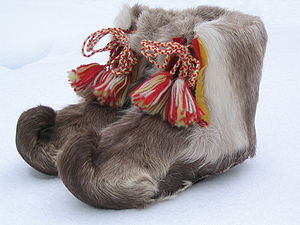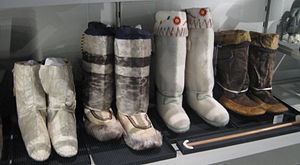Eskimo boots
Eskimo or Inuit boots are still essential footwear for the population of the Arctic region. The common names Kamik and Mukluk come from the Inuktitut language and simply mean “boots”.
Kamik (ᑲᒥᒃ [kaˈmik]) is the name of a boot among the Inuktutit in the Central and Eastern Arctic of Canada. Mukluk comes from the Yupik (from "maklak", the bearded seal ) and is common in the western Arctic, but it is also used by the North American Indians . Kamiik are a pair of boots, Kamiit are many boots. In their countries of origin, they are usually made of seal skin , caribou skin (reindeer) or other suitable and available types of fur .
Kamik is also the brand name for an industrially manufactured type of boot; boots of a similar type are now also offered outside of North America under the terms Kamik and Mukluk.
Classic mukluks and kamiks
The Eskimos' footwear is made in such a way that it provides optimal protection from the cold from the available, well-warming skins. Warm and effective footwear is essential for survival in the environmental conditions that prevail in many Eskimos' residential areas, with extreme cold and often severe storms. Even small openings due to open seams can lead to partial frostbite. The boots have to meet different requirements; the women in their homes need different shoes than the hunter, who often spends hours on the ice in front of a water hole. These different conditions are partially countered by wearing several layers on top of each other, the number of which can be reduced in warmer weather.
The footwear consists of a combination of fur stockings, slippers and boots, which are made of different furs and in different styles. The number of layers varies depending on the weather, region, activity and cultural affiliation. Seal boots have different shaft heights. They can reach mid-calf, thighs and, in the case of boots to be worn in the water, even up to the chest.
The boots, along with the rest of the traditional clothing, are also important to the Eskimos from a cultural point of view. The older women pass on their traditions orally to the younger seamstresses, who are interested in the traditional rituals and customs of division. While the use of fur parkas has declined sharply, they are mainly worn on festive occasions, kamiks and mukluks have shown their superiority over southern footwear in cold and wet weather and are still widely used.
materials
Originally, the Eskimos only used pelts for their footwear, namely the types of fur that were available in their area. These were mainly waterproof seal skins, thick-haired skins of the caribou and polar bears, flat-haired but durable caribou legs, and in the case of tribes living on islands, the hides of birds. For footwear, the skins were usually processed with the warming hair, but overshoes made of shorn or plucked fur were also used. In damp and damp spring and autumn, caribou boots with sealskin soles were preferred.
Other materials were depending Occurrence: Elchhäute , beluga -raw hides, wolf skins , wolverine furs , muskrat pelts , furs of Arctic Erdhörnchens , arctic fox furs and Rotfuchsfelle .
With the arrival of whalers, fur hunters and traders from the south, textiles were added as additional materials not only for footwear. Factory-made boots made of rubber or plastic are not liked by most hunters because, unlike the porous fur boots, the body's exhalation accumulates in them.
Boots of Inupiat , northwestern American Arctic, from bearded seals fur , arctic fox fur and fabric (1989)
Various Eskimo boots in the Museum of Vancouver , Canada
Manufacturing
The Eskimo footwear is made in such a way that it forms an optimal protection against the cold from the available, well-warming skins, at the same time its design should express the cultural differences between the individual groups. The transitions are quite fluid; when a seamstress moves to a neighboring community, she often brings her previous knowledge there with her. The manufacture of clothing, including footwear, is traditionally still the task of women today, while the men, as hunters, took care of the procurement of food in the classic role distribution. In the main hunting season, sewing was forbidden due to taboos and the women helped with food supplies.
The production of classic footwear is long and complex. The work process of the boot production consists of the preparation of the skins, the design of the patterns, the cutting and the sewing of the skin parts. The tools used are the Ulu women's knife, scraper blades, scraper plates, stenter frames, needles, thimbles, sinews or threads and boot trees.
The fat and loose tissue of the sealskin is removed on the scraping board. After a few washes, it is stretched in a frame to dry. The skins are made supple through various working methods, above all walking, which used to be mainly soft chewing, and in some areas they are watered again with the addition of chemicals. For waterproof, damp weather kamiks, seal skins are also depilated with scissors; in the past, the hair was removed in various ways by plucking it out. The types of dressing vary considerably from region to region. The industrially tanned skins, which are also used throughout the Arctic today, are less suitable for certain uses, as they generally contain less fat in the leather and are therefore less waterproof. Regionally, the fur is then colored or bleached in the early spring sun at temperatures below freezing point. With deviations, the caribou skins are prepared in the same way as the seal skins.
The basic components of footwear are the upper leather, sole and shaft. There are three basic types of soles: hard folded (boat-shaped), soft folded and smooth, without folds. There are five variants of the upper leather: encompassing the entire foot, reaching halfway around the foot, covering the tip of the foot, extending up to the calf and forming a common part with the shaft. The shafts are mainly made in six heights: to the ankle, to the middle of the calf, to below the knee, knee-high, above-knee high and thigh-high. These different types of sole, upper leather, possibly a side strip and the shaft can be combined in many ways. Experienced seamstresses draw the patterns freehand on the fur; it is common today to apply them with previously made or passed on, reusable templates. These can be old, traditional or newly designed shapes.
Before sewing, the fur is soaked for a while, or only the seam edges are kept moist. In the 1990s, sewing was mostly done with a needle and thread, less often with a machine. Is sewn from right to left, with about five to six Schlingstichen per centimeter. It is important to make the seams as tight as possible and thus waterproof. Soles holes in hairy pelts are repaired by putting on a fur patch, whereby the thread coming from the inside must not completely pierce the patch so that it does not wear out when worn.
- Nunavut, Northern Canada footwear in 2007
Mukluk and Kamik as trade names
The names Mukluk and Kamik have now been adopted by industrial manufacturers of footwear for their products, which often do not correspond to Eskimo boots, while Kamik is a registered trademark for outdoor shoes. The attempt of the Inuit to have their patterns, which are mostly based on classical models, protected as intellectual property for themselves was probably unsuccessful.
supporting documents
- ↑ Inuktitut Living Dictionary: kamik . Retrieved April 15, 2015.
- ↑ a b c d e f g h i j k l Jill Oakes, Rick Riewe: The art of Inuit women: proud boots, treasures made of fur . Frederking & Thaler, Munich 1996, ISBN 3-89405-352-6 .
- ↑ www.wipo.int: Phillip Bird: Intellectual Property Rights and the Inuit Amauti. A case study. Prepared for The World Summit on Sustainable Development by Pauktuutit Inuit Women's Association . July 2002. Retrieved April 25, 2015.







